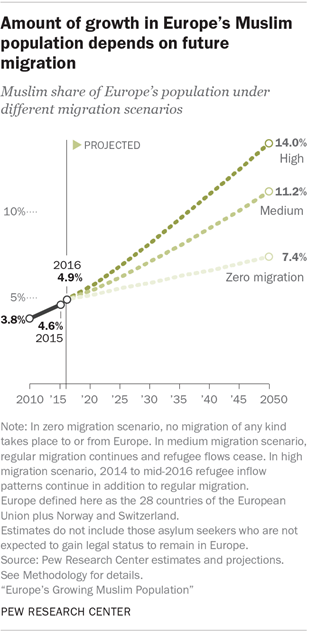Muslim population of Europe is projected to increase by at least 10 million in 2050
“Non-Muslim European women are projected to have a total fertility rate of 1.6 children, on average, compared with 2.6 children per Muslim woman in the region”, says a Pew Research study.
Pew Research · 05 DECEMBER 2017 · 18:16 CET

According to a study published this November by Pew Research, the Muslim population in Europe is growing steadily.
This is mainly because, in recent years, the continent has experienced a record influx of asylum seekers fleeing conflicts in Syria and other predominantly Muslim countries.
Pew Research Center has modeled three scenarios that vary depending on future levels of migration.
The baseline for all three scenarios is the Muslim population in the 28 European Union countries plus Norway and Switzerland, which, as of mid-2016, was estimated at 25.8 million (4.9% of the overall population), up from 19.5 million (3.8%) in 2010.
“ZERO MIGRATION SCENARIO”
The study describes a “zero migration” scenario, where “all migration into Europe were to immediately and permanently stop”.
Even in that scenario, “the Muslim population of Europe still would be expected to rise from the current level of 4.9% to 7.4% by the year 2050, which means that it is projected to increase by 10 million.
“This is because Muslims are younger (by 13 years, on average) and have higher fertility (one child more per woman, on average) than other Europeans, mirroring a global pattern”.
France would experience notable change even in this zero migration scenario, with the relatively young French Muslim population rising from 5.7 million (8.8% of the population) to 8.6 million (12.7%).
“MEDIUM MIGRATION SCENARIO”
A second, “medium” migration scenario “assumed that all refugee flows would stop as of mid-2016, but that recent levels of regular migration to Europe (migration of those who come for reasons other than seeking asylum) will continue”.
Under these conditions, Muslims could reach 11.2% of Europe’s population in 2050, around 58 million Muslims.
The UK, which has received more regular Muslim migrants in recent years than any other European country, would have the continent’s largest Muslim population by 2050 under this scenario.
“HIGH MIGRATION SCENARIO”
The “high migration scenario projects the record flow of refugees into Europe between 2014 and 2016 to continue indefinitely into the future with the same religious composition”: mostly Muslims, along with the typical annual flow of regular migrants.
In this scenario, “Muslims could make up 14% of Europe’s population by 2050 (75 million), nearly triple the current share, but still considerably smaller than the populations of both Christians and people with no religion in Europe”.
Under the high migration scenario, Germany would have by far the biggest Muslim population in Europe in 2050 , with 17.5 million, or about one-in-five Germans, because Germany has accepted the greatest number of Muslim refugees in recent years.
“THE MOST REALISTIC SCENARIO IS BETWEEN THE MEDIUM AND HIGH”
With these scenarios, Pew “does not aim to predict what will happen in the future, but rather a set of projections about what could happen under different circumstances”.
According to the study, “the most realistic endpoint for Europe may be somewhere between the medium and high migration scenarios, meaning Muslims could make up between 11.2% and 14% of Europe’s population in 2050”.
ASSYLUM SEEKERS AND REFUGEES
The impact of these scenarios is uneven across different European countries; due in large part to government policies, some countries are much more affected by migration than others.
That is why Pew believes that “one source of uncertainty is the status of asylum seekers who are not granted refugee status”.
Based on recent rates of approval of asylum applications, Pew Research Center “estimates that nearly a million (970,000) additional Muslim asylum seekers who came to Europe in recent years will not have their applications for asylum accepted”.
However, “of the roughly 1.6 million people who received refugee status in Europe between mid-2010 and mid-2016 (or are expected to have their applications approved in the future), more than three-quarters (78%, or 1.3 million) were estimated to be Muslims”.
HIGHER FERTILITY RATES AMONG MUSLIM WOMEN
Migration aside, “fertility rates are among the other dynamics driving Europe’s growing Muslim population”, the study explains.
“Europe’s Muslims have more children than members of other religious groups (or people with no religion) in the region”.
Although “not all children born to Muslim women will ultimately identify as Muslims, children are generally more likely to adopt their parents’ religious identity than any other”, Pew points out.
Taken as a whole, “non-Muslim European women are projected to have a total fertility rate of 1.6 children, on average, during the 2015-2020 period, compared with 2.6 children per Muslim woman in the region”.
“This difference of one child per woman is particularly significant given that fertility among European Muslims exceeds replacement level ( the rate of births needed to sustain the size of a population) while non-Muslims are not having enough children to keep their population steady”, the study concludes.
Published in: Evangelical Focus - europe - Muslim population of Europe is projected to increase by at least 10 million in 2050


